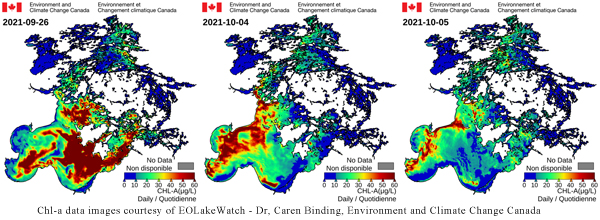- Details
 The Proceedings Report of the 2022 International Rainy-Lake of the Woods Watershed Forum is available for download at the Foundation’s website: lowwsf.com/forum-proceedings. Held March 9-10 as a virtual online event, 144 researchers, resource managers, policy makers, and members of the public put Lake of the Woods and its watershed under the microscope. The report covers a wide range of subjects: including: water governance and Indegenous perspectives, the State of the Basin Report, nutrients & algae, invasive species, and emerging issues and technologies.
The Proceedings Report of the 2022 International Rainy-Lake of the Woods Watershed Forum is available for download at the Foundation’s website: lowwsf.com/forum-proceedings. Held March 9-10 as a virtual online event, 144 researchers, resource managers, policy makers, and members of the public put Lake of the Woods and its watershed under the microscope. The report covers a wide range of subjects: including: water governance and Indegenous perspectives, the State of the Basin Report, nutrients & algae, invasive species, and emerging issues and technologies.
Most presentations were recorded and are available for viewing for a limited time at lowwsf.com/watershed-forum.
Please download a copy of the report or go to the website to view any presentation recordings that are of interest to you.
- Details

Great news! Canada's Budget 2022, released today, includes funding that should help kickstart actions to restore the waters of Lake of the Woods. Specifically as it relates to Lake fo the Woods, Budget 2022 proposes:
- $43.5 million over five years, starting in 2022, to Environment and Climate Change Canada (ECCC) to create the new Canada Water Agency, which is to have a madate for the large rivers and lakes in Canada such Lake of the Woods.
- $19.6 million in 2022-23 to ECCC to a Freshwater Action Plan (the future after 2023 of this initiative will be announced later) -- This funding will support clean up efforts in our major waters - specifically including Lake of the Woods, along with the Great Lakes, the St. Lawrence River, Lake Winnipeg, the Fraser River, the Saint John River, the Mackenzie River, and Lake Simcoe.
In 2019, the Canadian government committed to establish a federal Canada Water Agency to work with provinces, territories, Indigenous communities, and other stakeholders in order to find the best ways to keep Canada’s water safe, clean, and well-managed. Budget 2022, committs that the CWA will be up an running this year (2022). We expect that this will move our objectives of developing an plan for Lake of the Woods forward, with phosphorus pollution reduction targets to address toxic algae in the lake.
- Details
Heartfelt thank you to a true Lake of the Woods ambassador, Art McKenzie
 A huge “thank you” to Art McKenzie for his decades of volunteer service to Lake of the Woods, as a founding Director and Treasurer of the Lake of the Woods Water Sustainability Foundation, and before then, a long time Director and President of the Lake of the Woods District Stewardship Association.
A huge “thank you” to Art McKenzie for his decades of volunteer service to Lake of the Woods, as a founding Director and Treasurer of the Lake of the Woods Water Sustainability Foundation, and before then, a long time Director and President of the Lake of the Woods District Stewardship Association.
Last fall, LOWWSF Directors met with Art to thank him in person — a ceremony delayed by COVID restrictions since Art’s retirement from the Foundation Board in June 2020. Tony Stephens, President of the Foundation, presented Art with a retirement gift honouring his contribution to our international lake and its watershed – a wood-cut map of the entire Lake of the Woods watershed.
From all of us at LOWWSF, a giant “thank you” to Art and best wishes for life in retirement at the lake!
- Details
By Bev Clark, for the Lake of the Woods Water Sustainability Foundation
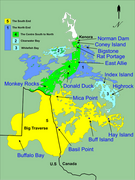 In this article, Bev Clark, takes a look at the tremendous variation in total phosphorus (TP), as a measure of water quality, across the vast expanse and five distinctly different areas of Lake of the Woods. Phosphorus is the primary nutrient that supports the growth of algae, and in excess can lead to sever blooms, widespread across much of the lake. Bev graphically presents average and ranges in TP for each lake area and discusses reasons for the diffenences and relatioship to the risks of developing algae blooms.
In this article, Bev Clark, takes a look at the tremendous variation in total phosphorus (TP), as a measure of water quality, across the vast expanse and five distinctly different areas of Lake of the Woods. Phosphorus is the primary nutrient that supports the growth of algae, and in excess can lead to sever blooms, widespread across much of the lake. Bev graphically presents average and ranges in TP for each lake area and discusses reasons for the diffenences and relatioship to the risks of developing algae blooms.
Bev Clark is one of the co-editors of the recently-released 2022 Rainy-Lake of the Woods State of the Basin Report, and this article summarizes a small aspect of the information from it.
- Details
The seasonal algae bloom on Lake of the Woods is underway and has progressed up into the north end of the lake, as shown in the collage of derived chlorophyll-a data for Sept 26 through Oct 5 (data imaged courtesy of EOLakeWatch, Dr. Caren Binding ECCC). The bloom has now developed in the northern part of the lake through to the Kenora area, and as can seen in the Chl-a data for Oct 4 & 5, the bloom is even present in the Ptarmigan channel / bay area of the "Clearwater" complex of bays. However, the blooms in these lower nutrient isolated bays may be a result of the strong shift...
- Details
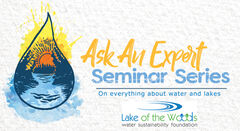 Over two hundred attended our five-part Ask and Expert webinar series this fall. Our lineup of experts had a wealth of knowledge and this was a great chance to connect directly with them. The webinars were recorded, so if you were not able to attend you can view the recordings at your leisure.
Over two hundred attended our five-part Ask and Expert webinar series this fall. Our lineup of experts had a wealth of knowledge and this was a great chance to connect directly with them. The webinars were recorded, so if you were not able to attend you can view the recordings at your leisure.
- Details
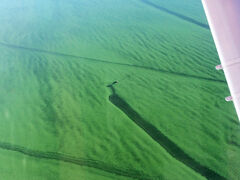 The Foundation has launched a project to develop a framework for a future phosphorus management plan for the Canadian portion of the binational Rainy-River-Lake of the Woods, with the support of a Contribution Agreement from Environment and Climate Change Canada (ECCC).
The Foundation has launched a project to develop a framework for a future phosphorus management plan for the Canadian portion of the binational Rainy-River-Lake of the Woods, with the support of a Contribution Agreement from Environment and Climate Change Canada (ECCC).
This project will scope and outline the key elements that would be required to develop a domestic phosphorus management plan collaboratively with relevant parties in the basin, once phosphorus targets are set by Canada domestically or as shared binational targets with Minnesota.
This work is timely now, to prepare for moving from research to action. In late June, the US EPA approved Minnesota’s phosphorus plan that sets phosphorus targets for each source to the Rainy River and Lake of the Woods. In Canada, ECCC completed public engagements last spring on potential phosphorus reduction scenarios based on its four-year science program (see the LOWWSF “What We Heard Report”).
- Details
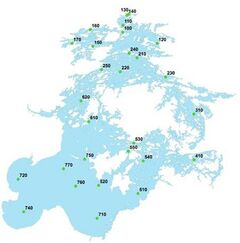 Environment and Climate Change Canada’s team responsible for sampling water quality on Lake of the Woods was out this September doing a lake-wide survey of 28 sites (see map). Water quality sampling had been paused last year due to Covid restrictions. In addition, they re-initiated their long-term monitoring of the Rainy River inflow to Lake of the Woods and the Winnipeg River outflow.
Environment and Climate Change Canada’s team responsible for sampling water quality on Lake of the Woods was out this September doing a lake-wide survey of 28 sites (see map). Water quality sampling had been paused last year due to Covid restrictions. In addition, they re-initiated their long-term monitoring of the Rainy River inflow to Lake of the Woods and the Winnipeg River outflow.
At each site, water quality parameters measured included: phosphorous, nitrogen, carbon and their various forms, total and dissolved metals, major ions, Chlorophyll a, Phycocyanin (an algal pigment found in blue-green algae), total suspended solids, algal toxins and taxonomy, secchi depths, dissolved oxygen, pH, turbidity, conductivity and temperature.

